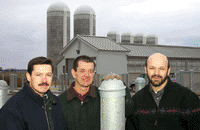New UK Beef Research Unit Will Have Major Impact on Kentucky's Beef Industry
New UK Beef Research Unit Will Have Major Impact on Kentucky's Beef Industry

Research to enhance Kentucky's cattle industry is about to take a quantum leap with the opening of the beef research unit at the University of Kentucky's College of Agriculture Animal Research Center located in Woodford County.
The actual move to the new facilities for the beef research team is still a few months away. For Eric Vanzant, David Harmon and Brian Larson, beef nutrition researchers in the UK College of Agriculture, it will be worth the wait.
The new buildings and equipment will provide UK scientists with the opportunity to work in an environment with few limitations to conduct critically needed research.
"It will certainly be the best beef research facility of its kind in the Eastern United States," said Harmon. "We may not rival the size of the research facilities of Nebraska or Missouri, but we will have all the capabilities of any beef research unit in the world."
Kentucky's 50,000 beef cattle operations will be the primary beneficiaries of the findings generated at the facility. There will be a strong emphasis on understanding the most efficient way to use Kentucky's extensive forage resources.
"When you look at the costs of raising a beef animal, the major portion is incurred for feed," explained Vanzant. "Anything that we can do to increase the efficiency of turning these feedstuffs into beef products lowers the input costs to the producer."
Cattle producers will recognize many of the components of the research unit, but there are some noticeable differences that distinguish it as a distinct environment for serious scientific study.
The primary components of the beef research facility include a state-of-the-art nutrition center and feed mixing system, enclosed animal- handling facility, group and individual feed facilities, an extensive arrangement of gated walkways, flexible forage and commodity storage area, and a manure composting unit.
The crown jewel of the beef unit is the intensive research building containing a large animal surgical center, climate controlled rooms for individual animal study, meeting rooms and lab facilities.
UK beef researchers emphasized that while there may be a general theme to their work, they intend to remain flexible and address timely and relevant needs as they arise.
Vanzant hopes to look at grass species that might compliment the growth cycles of fescue to produce pastures that provide a high-quality forage base all year long. He also wants to study feed supplements or additives that will increase the energy levels gleaned from grass forages.
Larson pointed out that the combination of an intensive research building, the group and individual feeding facilities and the numerous pastures will allow UK researchers to study the effects of a forage or feed supplement on cattle from "theory to the pastureland".
"Many research facilities contain one or two of these elements," noted Larson. "But rarely will you see a system that allows you to study an animal in all three settings."
"Our College administration is seeking some additional funding to build a cow-calf unit which would allow us to study feeding cycles from conception to consumption, said Vanzant. "That would complete what is already poised to be an extremely significant research tool for Kentucky producers."
Harmon emphasized the new facilities that are almost in place would also allow the UK researchers access to critical research funding.
"To do the research that we need to do in this day and age demands critical environment controls," said Harmon. "We can't obtain federal and private grant money unless the facilities meet stringent government and even private funding source guidelines."
Multi-use gates, non- slip walkways and well-lit handling facilities attest to the fact that the entire complex was designed with the health and safety of both animals and handlers in mind.
Environmental issues such as water quality also will be addressed by studying the best ways to raise livestock while meeting the more stringent standards being established at both the federal and state levels.
"Although this unit is not geared toward your typical demonstration farm there will be a number of different sites on the farm that will relate to animal behavior, management and water quality, grass variety trials, shade systems, and related issues, " added Harmon.
UK Cooperative Extension personnel will use the facility for agent training and producer updates. UK Extension beef specialists like John Johns feel training is important, but that the first priority should be to provide the answers to distinct Kentucky problems.
"We need help with issues like how to control the effects of the fescue endophyte problem and this facility can do that job," said Johns. "The ability to individually feed animals is such a big step beyond what we have ever been able to do. It means we can use fewer animals to get accurate answers to important questions that plague our producers."
The beef unit is one of three animal research facilities units that will formally begin research activities by year's end. The College is seeking additional funding for an education center, a dairy research facility and a cow and calf unit.
